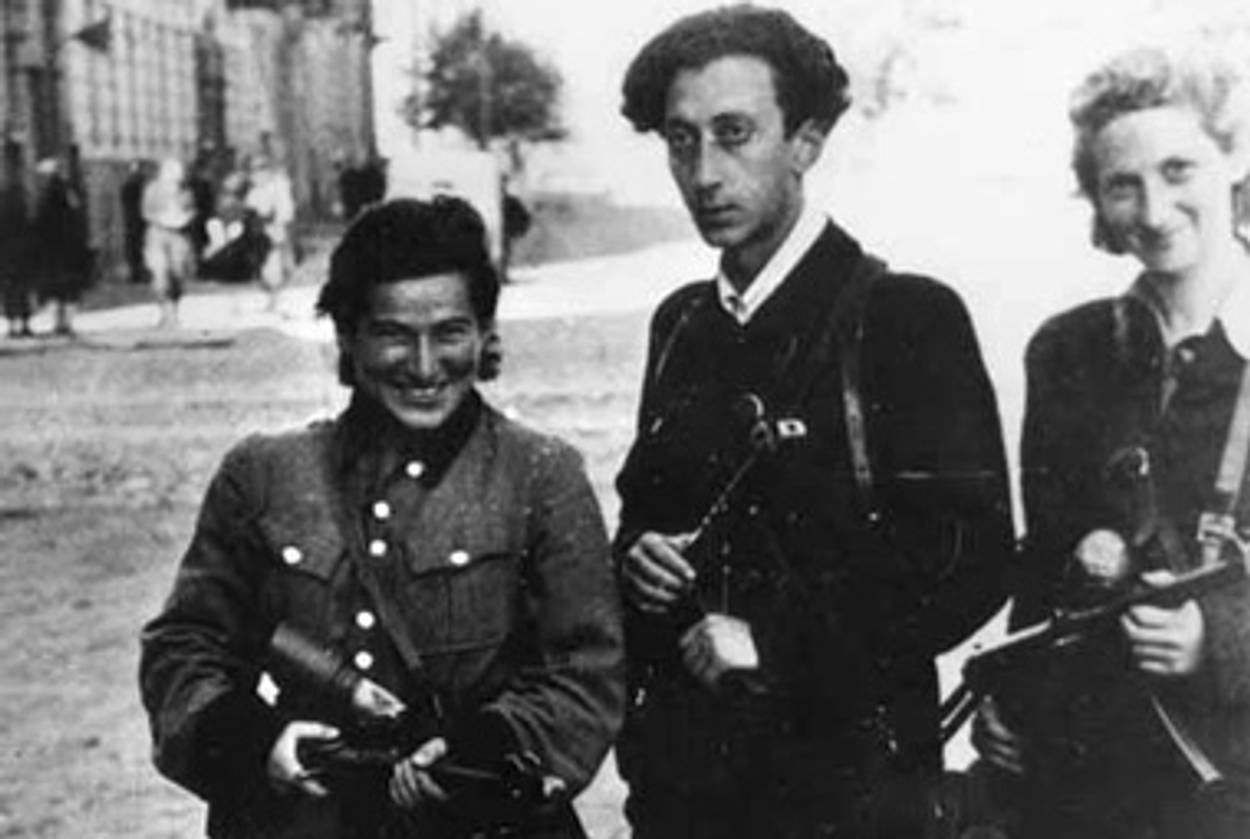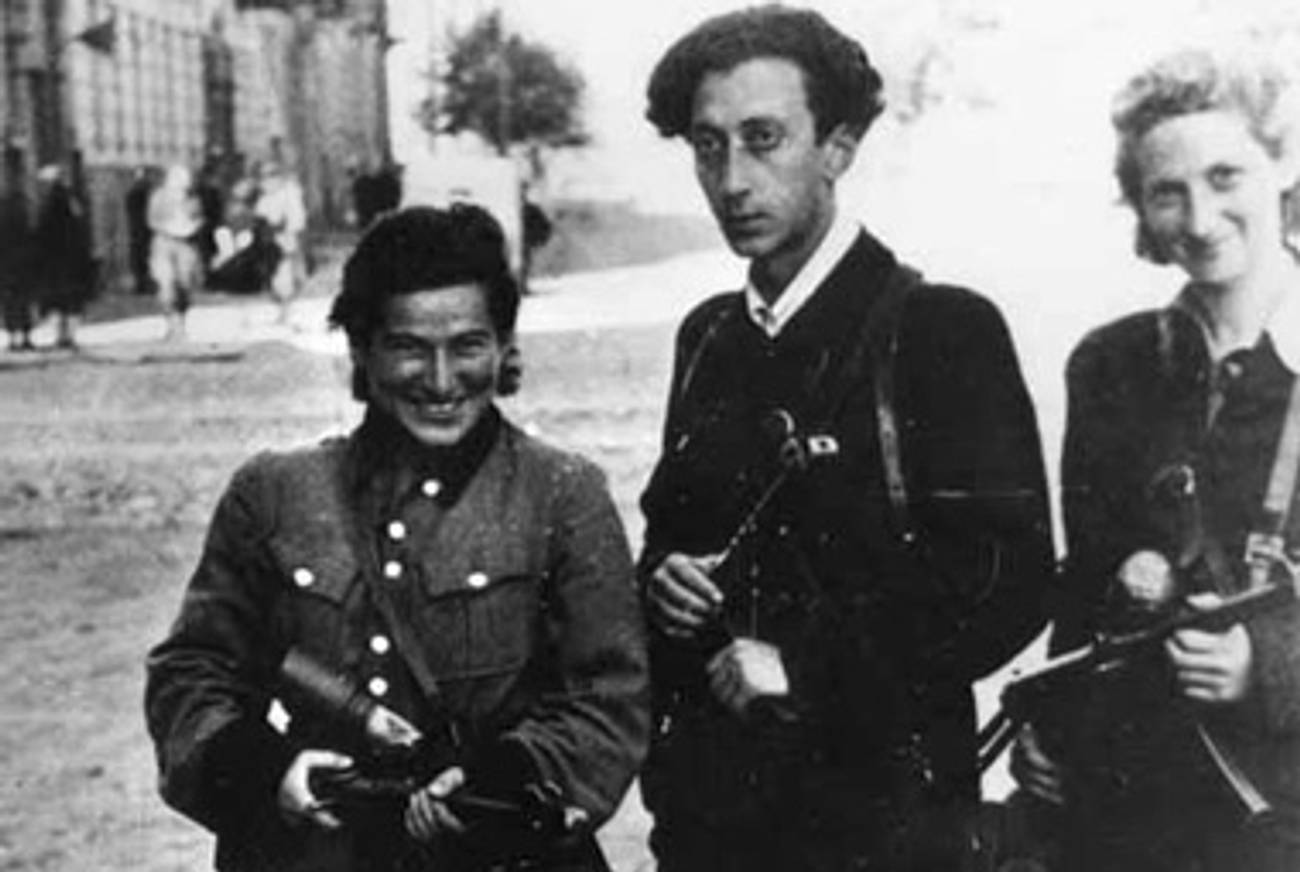Partisan Poet
A biography examines the life of ghetto insurgent and Zionist bard Abba Kovner




The story of Abba Kovner is one that—as we say about the exodus from Egypt on Passover—every Jew has a duty to learn and to tell. Because it is a Holocaust story, however, it cannot be a tale of rescue and salvation, as the exodus was. For the Jews of the Vilna ghetto, God’s “mighty hand and outstretched arm” were absent; the waters did not miraculously part to save them and drown their persecutors. On the contrary, no Jewish community was more totally destroyed than that of Vilna, the ancient center of Jewish learning that was celebrated as “the Jerusalem of Lithuania.”
As a result, Kovner’s story—his work as a leader of the ghetto’s underground, his escape from Vilna to lead a Jewish partisan band in the forests, his role in organizing the postwar migration of refugees to Israel, and his part in the 1948 War of Independence—does not bring the kind of satisfaction or inspiration we turn to legends to find. If Kovner was a hero—and if he wasn’t, who is?—he is a new kind of hero, one we have to pity as well as admire. After all, we do not expect heroes to spend decades, as Kovner did, screaming in their sleep. “For thirty years I had a recurring nightmare, the same one every night,” he said in 1980, seven years before he died. “My feet were running through dark alleys, from one to another with no exit, the faces of the people chasing me were invisible and I could only hear them yelling, ‘Raus, raus,’ and they were almost on top of me…. Then I would wake up, dripping with sweat and terrified.”
The Fall of a Sparrow: The Life and Times of Abba Kovner, by Dina Porat, is the first full biography of Kovner to appear in English. But the book was originally published in Hebrew, in 2000, and it presents a few obstacles to the American Jewish reader—of which the sometimes awkward translation is the least important. Porat is writing for a readership with a deeper knowledge of early Zionist ideologies and personalities, and of Israeli culture and history, than most Americans are likely to possess. Yet this Israeli perspective, for all its challenges, is especially useful when it comes to understanding Kovner. Not only did he spent his whole postwar life in Israel, living on the Ein Hahoresh kibbutz; the idea of Israel, and the often painful contrasts between the ideal and the reality, shaped Kovner’s whole life and personality, even before the Second World War. If it weren’t for his fervent Zionism, Kovner could never have assumed the terrible moral and practical burdens of leadership in occupied Vilna.
“Kovner was unmistakably a born leader,” Porat writes. Not only did his name mean “father,” but he was related to the Vilna Gaon, 19th-century Lithuania’s greatest rabbi and polymath. Yet one of the central ironies of Porat’s book is that, for Kovner and many Jews of his generation in Eastern Europe—he was born in 1918—commitment to Jewishness was expressed as a rejection of Judaism. As head of the Vilna chapter of Hashomer Hatzair, the socialist Zionist youth movement, Kovner was adamantly secular and revolutionary. (As Porat shows, he even exaggerated his family’s poverty in order to fit in better with the proletarian ideal.) Hashomer Hatzair provided the basic structure of Kovner’s world: it put him in touch with like minded young Jews across Europe and in Palestine, and it gave him an ideal of absolute commitment and self-sacrifice.
Both of these legacies were to prove crucial during the Nazi occupation, and it is no coincidence that both Kovner, the leader of the Vilna underground, and Mordechai Anielewicz, the leader of the Warsaw Ghetto Uprising, were members of Hashomer Hatzair. As Porat shows, these two young men, along with hundreds of other Zionist activists, were briefly united in Vilna in 1939, when the independent state of Lithuania became a refuge for Jews fleeing Nazi-occupied Poland. It was even possible for some older Zionists to escape to Palestine; but Kovner, who was just 21 years old, decided to remain in Vilna, just as Anielewicz deliberately returned to Warsaw. At this crucial moment, Zionism was transformed for Kovner from a dream of Palestine to a doctrine of Jewish self-reliance. At an age when most young people are still in college, Kovner and his peers decided that they were “the only ones left ‘to stand guard over Jewish lives, now and in the future.’”
That resolve would be tested immediately, as Lithuania was first annexed by the Soviet Union, in 1940, and then conquered by Nazi Germany, in 1941. The sequence of events was triply disastrous for the Jews. The Soviets, who were idealized by the young socialists of Hashomer Hatzair, turned out to be as hostile to left-wing Zionism as they were to Orthodox Judaism. The movement had to go underground—in Porat’s words, “to continue admiring the regime while hiding from it.” But enough Jews welcomed the Soviets—either because they were committed Communists, or because they saw Stalin as their last defense against Hitler—that the Lithuanian population came to identify the Jews at large with the hated Russian occupiers. When the country fell to the Nazi onslaught in June 1941, its Jews were left to face an aggrieved, anti-Semitic population, whipped up by the Germans to a genocidal frenzy. As a result, the Holocaust in Lithuania was quicker and deadlier than anywhere in Europe. By December 1941, more than two-thirds of Vilna’s Jews had been murdered, mainly by shooting at a mass grave in Ponar, outside the city.
The survivors were imprisoned in the Vilna Ghetto, a tiny, impoverished, walled-in enclave. During the worst of the killing that fall, Kovner and some 20 other Jews were in hiding, protected by the mother superior of a Catholic convent who ran enormous risks to save them. (After the war, Kovner would call this heroic nun Ima, “mother.”) But in December he decided to emerge from hiding and slip into the ghetto, in order to provide the leadership he believed it desperately needed. For the next two years, as Porat shows in detail, Kovner helped to unite Vilna’s fractious Jewish political movements into a single underground, the Fareinikteh Partizaner Organizatzieh (United Partisan Organization), or FPO. At the constant risk of his own life—and worse, of incurring collective punishment on the ghetto—Kovner and the other FPO leaders organized cells, obtained weapons, wrote orders and manifestos, and planned to fight the Germans.
They knew, of course, that there was no way they could defeat the occupiers, or even inflict serious damage. The underground’s strategy was premised on the belief, which Kovner announced in a manifesto on January 1, 1942, that the Nazis intended to kill every single Jew in Europe—making Kovner perhaps the first Jew to publicly acknowledge the true nature of the Holocaust. Effectively, the Jews of the Vilna Ghetto were already dead. The only choice that remained to them was how they would die. “Let us not go like lambs to the slaughter!” Kovner wrote, in a terrible and famous phrase. “True, we are weak and helpless, but the only answer to the hater is resistance! Brothers! Better fall as free fighters than live at our murderers’ mercy!”
All the FPO’s planning, then, was devoted to a final, apocalyptic battle in the ghetto, in which the Jews would kill some of the enemy before their own inevitable deaths—like Samson pulling down the temple on the Philistines. This awful, hopeless revenge was the last possible form of self-determination, the last ember of the Zionist ideal. And even that was to be taken away; for Vilna, unlike Warsaw, never witnessed an uprising. The Jewish population, in whose name the FPO claimed to be fighting, adamantly opposed any attempt at resistance—encouraged in this by the ghetto’s Jewish ruler, Jacob Gens, who saw the underground as reckless youths who were endangering all their lives. When the ghetto was liquidated and the Germans captured a large fraction of the FPO’s fighters, the idea of resistance—which had sustained these young Jews during two years of hell—fell to pieces. “Suddenly we understood that after all our training and preparation we were still like all the other Jews, no different from them,” remembered Vitka Kempner, Kovner’s wife and fellow partisan. “It was the most awful and tragic helplessness. And that helplessness was the essence of the Holocaust.”
But Kovner found an alternative to helplessness. In September 1943, as the last Jews were rounded up for deportation, he led a group of 90 partisans out of the ghetto through a sewer pipe, making sure he was the last person to leave. After seven hours of crawling through three-foot wide pipes full of sewage, the group emerged in Vilna, then made its way to the Lithuanian forests. There Kovner assembled a Jewish partisan band, under the uneasy sponsorship of the USSR, and carried out sabotage and reprisal raids on the Germans and their collaborators. He managed to survive and to keep his group intact, despite strong anti-Semitic pressure from his Soviet commanders, until the Red Army liberated Vilna in July 1944. Porat reproduces a photo of the 25 year old Kovner, with Kempner and another female leader, Ruzka Korzcak, in the liberated ghetto. They are posing with rifles and smiling, but the streets behind them are empty.
Porat goes on to tell the equally dramatic story of Kovner’s role in leading survivors across Poland and Europe to Palestine; his terrible plan, thankfully never carried out, to inflict a genocidal revenge on the Germans, by poisoning the water supply of German cities; and the tense negotiations between Kovner and the survivors, on the one hand, and the government of the Yishuv in Palestine, on the other. Porat makes clear that, in a sense, Kovner never really belonged in Israel—even though his Zionism was all that sustained him through the Holocaust, and even though he became famous in the 1948 war for the powerful, angry bulletins he wrote as an information officer in the Givati Brigade.
For the rest of his life, as he wrote poetry, planned Holocaust memorials and museums, and worked on his kibbutz, Kovner belonged in some sense to the past—to the Vilna that was destroyed, to the partisan bands that were scattered and killed, to the Zionist idealism that existed before the founding of the actual state of Israel. He felt this difference above all in his poetry, Porat writes. Kovner “looked forward to the day when the kibbutz would also be the place his poetry belonged, natural and authentic like that of his fellow poets who had been born on the kibbutz; Kovner had been jealous of them for years. His first poem about the vineyard, whose grapes ran with blood instead of juice, asked the question, “‘How, my friend, is my poetry different from yours?/ The place of its birth, the date of life/ or the fact it tastes of ashes?’” What Kovner did cannot be separated from what he suffered; that is what makes his story so difficult to tell, and so necessary to remember.
Adam Kirsch is a contributing editor to Tablet Magazine and the author of Benjamin Disraeli, a biography in the Nextbook Press Jewish Encounters book series.
Adam Kirsch is a poet and literary critic, whose books include The People and the Books: 18 Classics of Jewish Literature.
Adam Kirsch is a poet and literary critic, whose books include The People and the Books: 18 Classics of Jewish Literature.